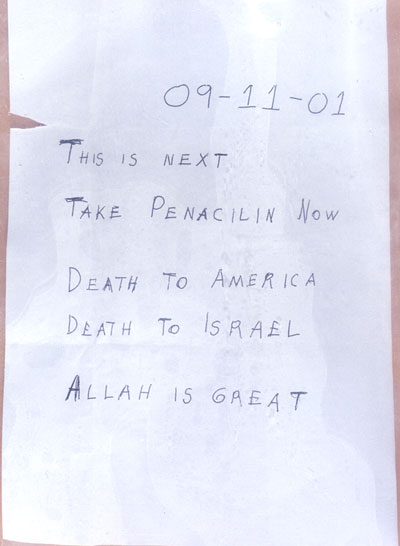|
The anthrax letters and
envelopes in the following illustrations are photographs released by the
American Justice Department on 23 October 2001.
It has not been forensically
proven whether or not these anthrax letters were written by one person
or more. It has also not been established whether the writer has
disguised his handwriting or not.
Bearing this in mind, this is a
purely graphological assessment of the handwriting as seen in these
letters.
Sample 1

From a purely graphological
point of view these samples are very interesting. Despite the fact that
an assessment from a photographic reproduction is at best limited, and
although we lose a lot by not being able to see the texture and pressure
of the writing, nevertheless there are a number of observations that we
can make about the actual handwriting itself.
The first impression we receive
from the handwriting is that the writer uses a lot of care in the
formation of the letters which makes one suspect that he or she is not
comfortable with writing in English.
Notice how the word "penacilin"
is spelt incorrectly in the following sample while in the third sample
below, you will see how even the question mark seems unfamiliar because
of its laboured construction.
Sample 2

Everything is carefully
executed. The obvious concentration on precision is particularly
noticeable where we see not only the careful printing of letters, but
also the scrupulously crossed t-strokes and the carefully placed full
stops at the end of each sentence.
You will have observed that all
the letters are written as capitals. But notice how the first letter of
each word is larger than the rest of the word that follows. Together
with the heavy t-strokes and the downward slope of the lines these signs
can be seen as an attempt to intimidate.
The actual letter formations are
unsophisticated. The uneven though heavy pressure, uneven baselines,
varied slant, inconsistencies in size, numerous retracings, and strong
downward tendency all attest to this.
Furthermore, when these
indications are combined with the large spaces we find between words, we
see an obsessive personality who feels detached from his or her
surroundings.
We can infer that this person
shows a lack of belonging and feels alienated from those who surround
him.
Nevertheless, despite the
determination that comes through, there is an air of nervousness and
even explosive tension.
We see this in the uneven
pressure, retracing of letters, varied slant and wavy baseline. Notice
particularly the t strokes of the second sample above, where the strokes
have been retraced several times. Also the "A" of Allah has been
retraced several times.
In the next sample, notice how
the left margin widens towards the bottom of the page. This gives an
additional clue to the undercurrent of fervour that runs through the
letters like an exposed nerve. All this is of course borne out by the
content.
Sample 3

But there is also a strong
element of fatalism.
In this last sample, the "e" of
"we" in the second line falls well below the imaginary base line as does
the "r" in "America".
There are further indications of
this in other places such as the e in "die" in the third line.
These signs together with the
downward trend of the lines – particularly in the envelope - show an
acceptance of the inevitable.
These signs are further
supported by the slow execution of each letter as well as the precision
and care in the construction of the individual formations. This
intensifies the sense of purpose.
And so we see this not only as a
show of acceptance but also as an indication of unwavering determination
When we examine all these
indicators together - the heavy t- strokes, the dark though inconsistent
pressure, the carefully drawn punctuation marks, the meticulously formed
numerals in all the samples - we can only conclude one thing. That the
signs of intent and determination are not only evident in the content of
the letters; they also show up in every stroke of the pen and in every
letter formation.
Find out how to uncover the real
secrets of handwriting in
The Hidden Meaning of
Handwriting
This way to
The Hall of Nasties
|